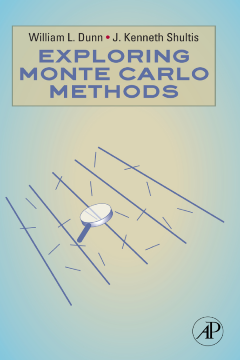
Additional Information
Book Details
Abstract
Exploring Monte Carlo Methods is a basic text that describes the numerical methods that have come to be known as "Monte Carlo." The book treats the subject generically through the first eight chapters and, thus, should be of use to anyone who wants to learn to use Monte Carlo. The next two chapters focus on applications in nuclear engineering, which are illustrative of uses in other fields. Five appendices are included, which provide useful information on probability distributions, general-purpose Monte Carlo codes for radiation transport, and other matters. The famous "Buffon’s needle problem" provides a unifying theme as it is repeatedly used to illustrate many features of Monte Carlo methods.
This book provides the basic detail necessary to learn how to apply Monte Carlo methods and thus should be useful as a text book for undergraduate or graduate courses in numerical methods. It is written so that interested readers with only an understanding of calculus and differential equations can learn Monte Carlo on their own. Coverage of topics such as variance reduction, pseudo-random number generation, Markov chain Monte Carlo, inverse Monte Carlo, and linear operator equations will make the book useful even to experienced Monte Carlo practitioners.
- Provides a concise treatment of generic Monte Carlo methods
- Proofs for each chapter
- Appendixes include Certain mathematical functions; Bose Einstein functions, Fermi Dirac functions, Watson functions
"Anyone interested in learning about the basics of the Monte Carlo method, and its potential applications, will find this an excellent book…ideal book for an undergraduate or graduate course in mathematics or statistics." --IEEE Electrical Insulation Magazine
"Emphasizing the burgeoning practical applications rather than strict mathematical rigor of methods that have been used for about a century, this text is intended as an introduction for undergraduate or graduate courses, as a self-teaching guide, and as a reference. The first eight chapters are generic and are relevant to applications in any field. They include discussion of history and definition; the basis; sampling, scoring, and precision; variance reduction techniques; Markov chain and inverse Monte Carlo; and linear operator equations. Following are two chapters on radiation transport, a field familiar to authors William L. Dunn and J. Kenneth Shultis (both are nuclear engineers affiliated with Kansas State U.), but the focus remains on general principles that can be applied in many fields. Each chapter includes examples and problems and exercises. Five appendices contain supporting material." --Reference and Research Book News
"Overall, the book is very well written, and the contents are concisely and logically introduced. It should be very useful as a textbook for undergraduate or graduate courses in numerical methods employing Monte Carlo techniques like molecular simulations." --Contemporary Physics
